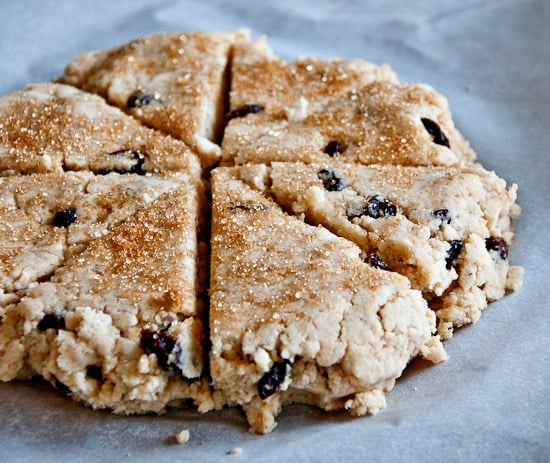In a cook book of the same name as today's title, co-authors Leslie Weiner & Barbara Albright provide recipes for over six dozen different scones. A traditional breakfast treat or accompaniment for afternoon tea in the British Isles, there are many regional variations on the scone theme. They go by a variety of interesting monikers such as Singing Hinnies, Fat Rascals and Rock Cakes. And it seems that each household has its own specialty.
It's difficult to describe the perfect scone, since they can vary so widely in texture, shape, size and flavor. They should be neither too dry nor too moist. Scones can vary from cookie-like to cake-like in texture, and from savory to sweet in flavor. So in the final estimation the ones that are "the best" are the ones you like to eat.
 Making scones is similar to making biscuits. They can be rolled, shaped, or dropped. they should be baked in a fully preheated oven for the specified time and cooled as directed. They, of course, are best consumed right away but can be successfully stored in an airtight container at room temperature.
Here is my favorite recipe from the Simply Scones cookbook:
Making scones is similar to making biscuits. They can be rolled, shaped, or dropped. they should be baked in a fully preheated oven for the specified time and cooled as directed. They, of course, are best consumed right away but can be successfully stored in an airtight container at room temperature.
Here is my favorite recipe from the Simply Scones cookbook:
GINGERBREAD SCONES
2 cups all-purpose flour 1/2 teaspoon salt
1/3 cup firmly packed dark brown sugar 1/3 cup unsalted butter, chilled
2 teaspoons baking powder 1 large egg
1/8 teaspoon baking soda 3 tablespoons molasses
1/2 teaspoon ground ginger 3 tablespoons whole milk
1/2 teaspoon ground cinnamon 1 teaspoon vanilla extract
1/8 teaspoon ground cloves 1/2 cup golden raisins (optional)
1/8 teaspoon ground nutmeg
Preheat oven to 375F. Lightly butter a 10" diameter circle in the center of a baking sheet. In a large bowl, stir together the flour, brown sugar, baking powder, baking soda, ginger, cinnamon, cloves, nutmeg, and salt. Cut the butter into 1/2" cubes and distribute them over the flour mixture. With a pastry blender or two knives used scissor fashion, cut in the butter until the mixture resembles coarse crumbs. In a small bowl, stir together the egg, molasses, milk and vanilla. Add the egg mixture to the flour mixture and stir to combine. The dough will be sticky. Stir in the raisins, if desired.
With lightly floured hands, pat the dough into an 8" diameter circle in the center of the prepared baking sheet. With a serrated knife, cut into 8 wedges. Bake 20 to 25 minutes or until a cake tester or a toothpick inserted into the center comes out clean. Remove the baking sheet to a wire rack and cool for 5 minutes. Using a spatula, transfer the scones to the wire rack to cool. Re-cut the wedges, if necessary. Serve warm.

 "Shaved turkey breast served warm on toasted 9-grain bread with melted cheddar cheese, basil pesto mayo and Applewood smoked bacon" is the way the sandwich is described, with "Slices of southern-fried green tomatoes (to) give it an extra crunch." While one may have reservations about the fried tomatoes and the bacon, certainly the turkey breast and 9-grain bread and basil sound healthy enough. Wrong!
"Shaved turkey breast served warm on toasted 9-grain bread with melted cheddar cheese, basil pesto mayo and Applewood smoked bacon" is the way the sandwich is described, with "Slices of southern-fried green tomatoes (to) give it an extra crunch." While one may have reservations about the fried tomatoes and the bacon, certainly the turkey breast and 9-grain bread and basil sound healthy enough. Wrong! The Turkey Club sandwich contains a whopping 1,210 calories and 19 grams (an entire day's worth) of saturated fat, to say nothing of the 3,980 milligrams of sodium (over 2.5 days worth). And those numbers don't include the fries that come with it, so says the article. But after all, what's another 390 calories and 720 mg of sodium?
The Turkey Club sandwich contains a whopping 1,210 calories and 19 grams (an entire day's worth) of saturated fat, to say nothing of the 3,980 milligrams of sodium (over 2.5 days worth). And those numbers don't include the fries that come with it, so says the article. But after all, what's another 390 calories and 720 mg of sodium?






































